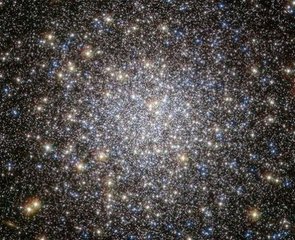This is Scientific American 60 Secomds, Space. I'm Clara Moskowitz, got a minute?
這里是科學美國人60秒,太空系列。我是克拉拉·莫斯科維茲。
If galaxies were high school lunchrooms, the star cluster named HVGC-1 would be a social pariah. This unpopular cluster has been kicked out of its galaxy and forced to wander the cosmos alone.
如果說銀河系是學校食堂,HUGC-1 星團就像是一個餐廳里不受歡迎的學生。遭到排斥的HUGC-1星團被星系拒之門外,只好孤獨地在宇宙中徘徊。

HVGC-1 stands for hypervelocity globular cluster 1. Its thousands of stars had been part of the M87 galaxy, about 50 million light-years away. But now the cluster is fleeing that galaxy at more than two million miles per hour. Researchers reported the discovery in The Astrophysical Journal Letters.
HUGC-1指的是“超高速球狀星團1號”。星團中的星星是室女A星系的一部分,離地球大約5千萬光年遠。但現(xiàn)在星團正在以每小時兩百多萬英里的速度脫離星系。研究人員將這一報告發(fā)布在“天體物理雜志通訊”上。
Astronomers are not sure why HVGC-1 was exiled from M87. One theory suggests that gravitational interactions with a pair of supermassive black holes at the galaxy's center could have kicked out the cluster. Most galaxies contain a single giant black hole. If M87 is the product of a merger of two galaxies, it might host two central black holes in a binary system, researchers say.
天文學家也并不確定HUGC-1“慘遭排斥”的原因。其中一個說法是:星系中央兩個巨型黑洞的相互引力作用促使星團脫離銀河。大多數(shù)的星系中只有一個黑洞。如果室女A星系是由兩個星系結(jié)合產(chǎn)生的,那它很可能同時擁有兩個黑洞。
In fact, that same double black hole future might await the Milky Way when we collide with our neighboring galaxy, Andromeda, in a few billion years. At which point, some star cluster may find itself ejected from the Milky Way, just like the ostracized HVGC-1.
事實上,幾百萬年以后,當?shù)厍蚝拖膳窍蹬鲎矔r,具有雙黑洞的星系會等待銀河系。屆時,一些星團也會像HUGC-1星團一樣被銀河系“驅(qū)逐出境”。
Thanks for the minute for Scientific American 60 Secomds, Tech. I'm Clara Moskowitz.
感謝收聽。












